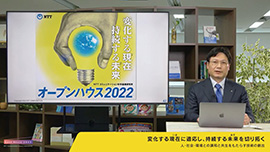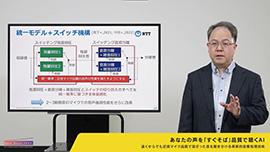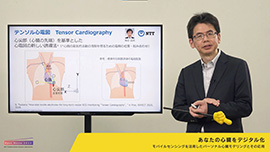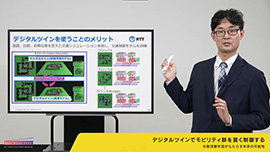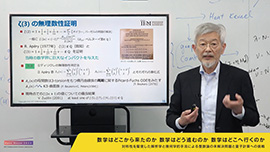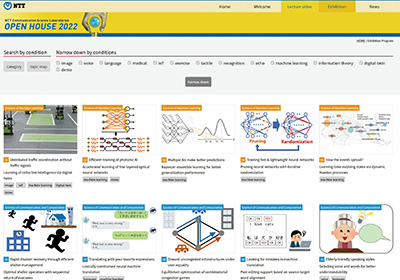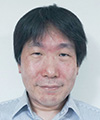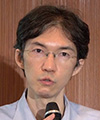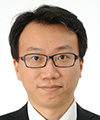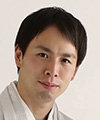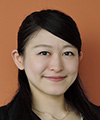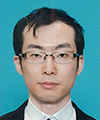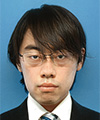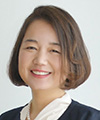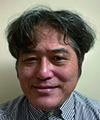 |
|||
|
|
|||
|
Information Vol. 20, No. 11, pp. 85–90, Nov. 2022. https://doi.org/10.53829/ntr202211in1 Event Report: NTT Communication Science Laboratories Open House 2022AbstractNTT Communication Science Laboratories Open House 2022 was held online, the content of which was published on the Open House 2022 web page at noon on June 2nd, 2022. The videos of 6 talks and 29 exhibits presented our latest research efforts in information and human sciences and were viewed more than 5000 times in the first month after the event. Keywords: information science, human science, artificial intelligence 1. OverviewNTT Communication Science Laboratories (CS Labs) aims to establish cutting-edge technologies that enable heart-to-heart communication between people and between people and computers. We are thus working on a fundamental theory that approaches the essence of human beings and information science, as well as on innovative technologies that will transform society. CS Labs’ Open House is held annually to introduce the results of our basic research and innovative leading-edge research with many hands-on intuitive exhibits to those who are engaged in research, development, business, and education. Open House 2022 was held online, as done last year, considering the situation against the spread of COVID-19. The latest research results were published with recorded lecture videos on the Open House 2022 web page at noon on June 2nd [1]. The content attracted many views in a month from NTT Group employees as well as from businesses, universities, and research institutions. The event content is still available. In the afternoon of the day before the online event, a pre-event was held at an NTT WEST’s open innovation facility QUINTBRIDGE in Osaka as the first on-site exhibition in three years. Visitors showed great interest in the eight exhibits, and the significance of the hands-on exhibits were reaffirmed. This article summarizes the online event’s research talks and exhibits. 2. Keynote speechDr. Futoshi Naya, vice president and head of CS Labs, presented a speech entitled “Communication science that adapts to the changing present and creates a sustainable future – Aiming to create technology that brings harmony and symbiosis with people, society, and the environment –,” in which he looked back upon the history of NTT and establishment of CS Labs then introduced present and future cutting-edge basic research and technologies (Photo 1).
Over the past 30 years since its founding on July 4, 1991, CS Labs has been promoting world-class basic research with the mission of constructing fundamental theories on the essence of human beings and information science and creating innovative technologies that will bring about communication that “reaches the heart.” After introducing the latest research results of CS Labs, Dr. Naya declared that CS Labs will promote synergies between different research areas to create new values other than research within each specific area, and explore new frontiers through interdisciplinary collaboration with various fields such as physics, basic mathematics, medicine, biology, social sciences, and philosophy. He also stated that CS Labs will engage in basic research in communication science to bring about natural harmony and symbiosis among people, society, and the environment. 3. Research talksThe following four research talks highlighted recent significant research results and high-profile research themes. Each talk introduced some of the latest research results and provided background and an overview of the research. After each talk, we received many questions from participants in real time during the question-and-answer (Q&A) session, and we could see that the viewers had a high interest in our researches. 3.1 “AI hears your voice as if it were ‘right next to you’ – Audio processing framework for separating distant sounds with close microphone quality –,” Dr. Tomohiro Nakatani, Media Information LaboratoryDr. Tomohiro Nakatani introduced advanced speech-enhancement techniques for extracting high-quality speech signals from degraded recordings with microphones distant from speakers, as if close microphones recorded them. When distant microphones capture a speech signal, they also record reverberation, background noise, and voices from extraneous speakers, degrading the quality of the captured speech signal. The techniques include a unified model for executing joint processing of dereverberation, denoising, and source separation, as well as a switching mechanism for enabling high-quality processing with a small number of microphones. He also discussed integration with deep-learning-based speech enhancement, e.g., SpeakerBeam (Photo 2).
3.2 “Making digital twin of your heart – Personal heart modeling with mobile sensing and its potential application –,” Dr. Kunio Kashino, Media Information Laboratory/Bio-Medical Informatics Research CenterDr. Kunio Kashino introduced the basic research he and co-researchers are conducting to actualize a future of healthcare using digital technology. Expectations for healthcare in modern life using digital technology are increasing every day. To support a more comprehensive approach, they are attempting to digitally model and replicate certain states and functions of the human body. In this talk, he introduced their initial trials focusing on the heart’s electrical and mechanical activities. He also discussed possible applications for their approach, including early detection of diseases and rehabilitation after treatment (Photo 3).
3.3 “Smart traffic coordination via digital twins – Future possibilities of distributed deep learning –,” Dr. Kenta Niwa, Innovative Communication LaboratoryDr. Kenta Niwa introduced his latest research on collective intelligence formation and distributed cooperative control via digital twins. For the next innovation in the machine learning field, his research aims to optimally control large-scale systems, e.g., Internet of Things devices in the overall city, by learning collective intelligence from accumulated data on distributed devices. In this talk, Dr. Niwa introduced several research projects associated with smart traffic coordination via learnable digital twins (Photo 4).
3.4 “Where does mathematics come from? How does it proceed? Where it goes? – Challenges to unsolved problems in number theory and quantum computation by symmetry-based analysis and geometry –,” Dr. Masato Wakayama, Institute for Fundamental MathematicsDr. Masato Wakayama introduced arithmetic geometry, automorphic representations, and graph theory and representation/number theory, which are the mathematicians’ specialties of the Institute for Fundamental Mathematics, which was inaugurated in October 2021. In this talk, with several important historical examples in mathematics, he spoke on what kind of mathematics we have studied, how mathematics is progressing, and where mathematical research is heading in the future. He introduced the research connecting quantum interaction and number theory, and mentioned its position in the stream of modern mathematics (Photo 5).
4. Research exhibitionThe Open House featured 29 exhibits displaying CS Labs’ latest research results. We categorized them into four areas: Science of Machine Learning, Science of Communication and Computation, Science of Media Information, and Science of Humans. Each exhibit prepared videos explaining the latest results and published them on the event web page (Photo 6). Several provided online demonstrations or demo videos to make them similar to direct demonstrations. We also introduced four Q&A sessions for each of the four areas and received many questions from participants in real time during the sessions. As in the previous year, we also had a Q&A system in which page visitors could freely post questions and comments and CS Labs’ researcher answer them. There were more than 50 public questions, and some made showed the enthusiasm of the visitors, such as long question comments and professional questions.
The following list, taken from the Open House website, summarizes the research exhibits in each category. 4.1 Science of Machine Learning
4.2 Science of Communication and Computation
4.3 Science of Media Information
4.4 Science of Humans
5. Special lectureWe asked Professor Kazuo Okanoya, professor of Advanced Comprehensive Research Organization, Teikyo University, to give a special lecture entitled “Animal mind and communicative behavior,” and conduct a panel discussion with CS Labs’ researchers Makio Kashino, Tessei Kobayashi, and Sadao Hiroya. In the lecture, he talked about his research on bio-psychology of communication to speculate on the mental experiences of animals and elucidate the evolution and neural mechanisms of such mental experiences by measuring neural activities that correlate with behavior. He explained the need for a method of studying the “animal mind” as well as the science of the “human mind,” which is based on anthropomorphism, although the study of the “animal mind” has been discouraged as anthropomorphism. He explained that in communicative behavior, sending a certain signal changes the behavior of the receiver, which in turn allows the sender to gain some benefit, and he introduced videos of experiments with examples of animal behavior for such communication. He concluded by stating that the following are necessary for the mind of artificial intelligence: “communication,” similar to what animals do; “theory of mind,” a system for predicting the behavior of others; and “mirror neurons,” a system for converting the behavior of others into its own behavior. 6. Concluding remarksOpen House 2022 was held as an event to present our latest results on a website. The lecture videos were viewed more than 4000 times in June by various groups of users. Participants provided many valuable opinions that will encourage us in further research activities through interactive means of communication with CS Labs’ researchers such as the Q&A system and Q&A session at the exhibition and lectures. In closing, we would like to offer our sincere thanks to all the participants of this online event. Reference
|
|||









